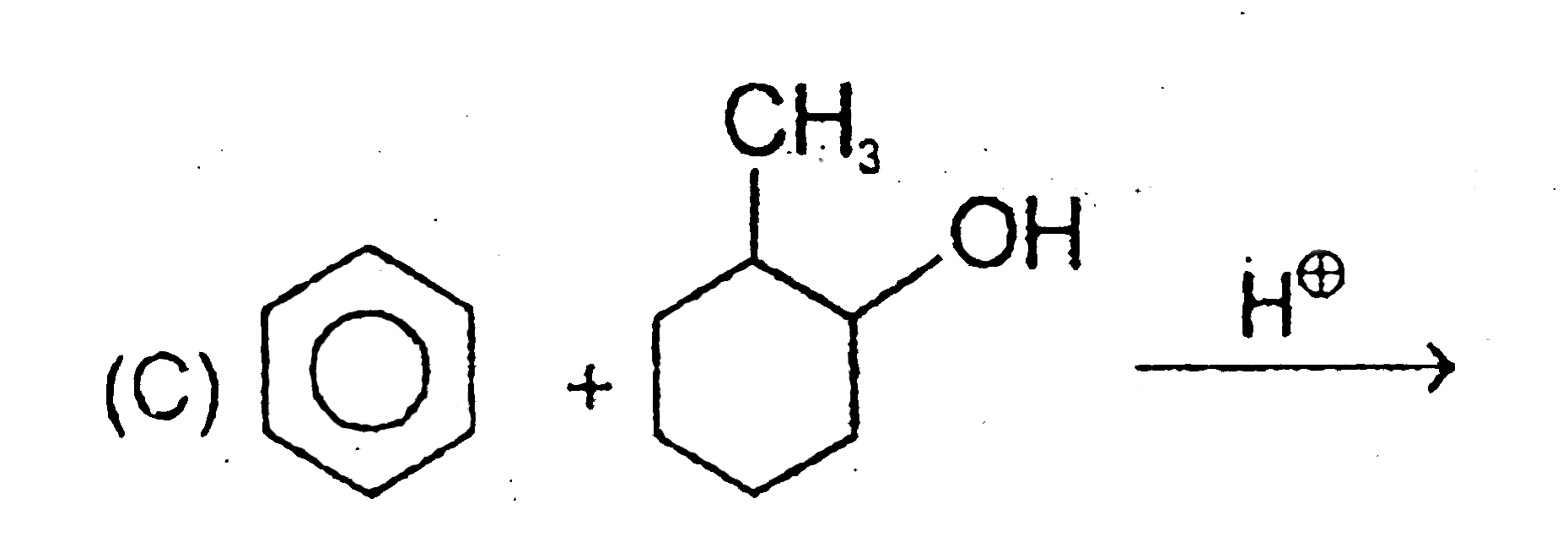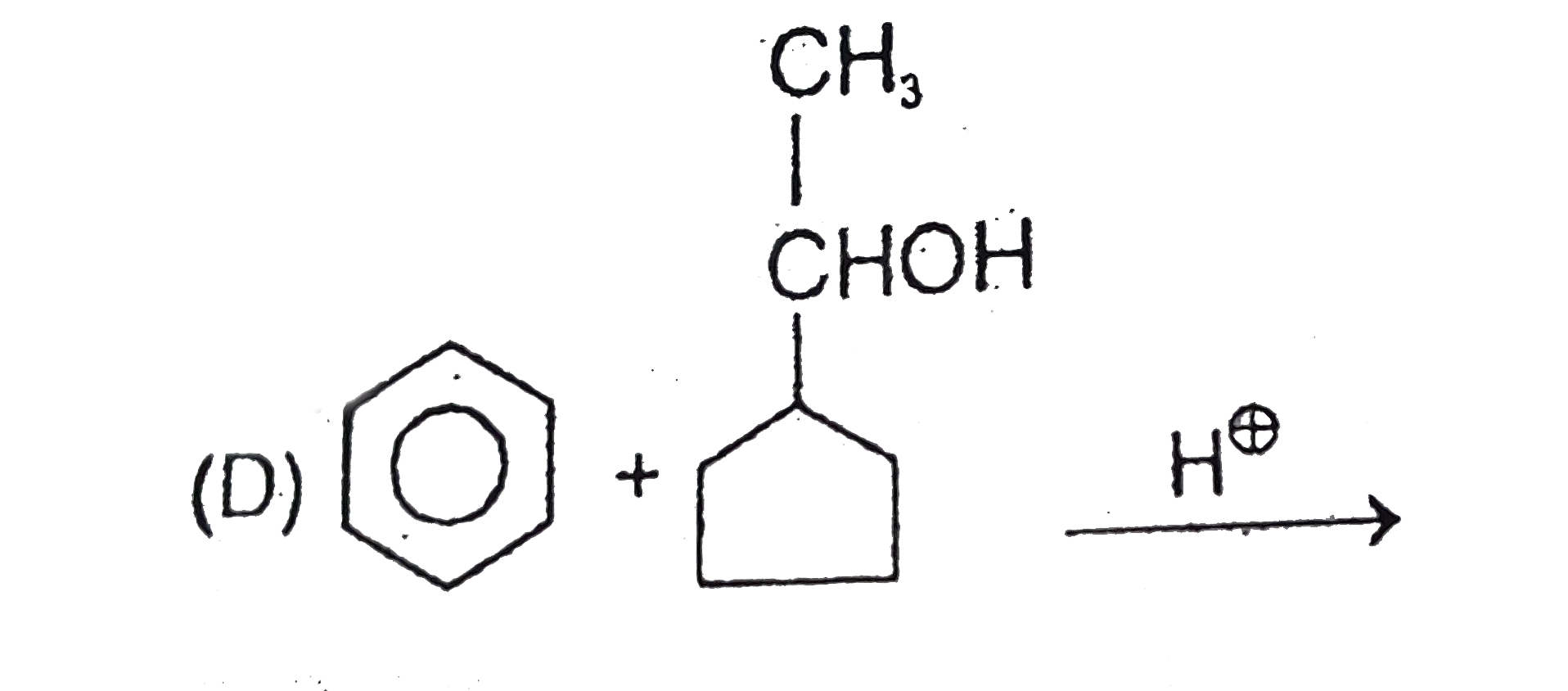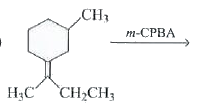Which of the following reaction/s give same product?




The correct Answer is:A, B, C, D
To determine which of the given reactions produce the same product, we will analyze each option step by step.
Step 1: Analyze Option A
1. Reactants: Benzene ring and a 5-membered ring with a CH=CH2 group.
2. Protonation: The alkene (CH=CH2) gets protonated, forming a carbocation on the adjacent carbon.
3. Carbocation Stability: The initial carbocation formed is a 1-degree carbocation, which is less stable than a 2-degree carbocation. Therefore, rearrangement occurs to form a more stable 2-degree carbocation.
4. Ring Expansion: The 5-membered ring expands to a 6-membered ring due to the rearrangement.
5. Final Product: The benzene ring attacks the carbocation, leading to the formation of a substituted benzene product.
Step 2: Analyze Option B
1. Reactants: Benzene ring with a CH3 group and Cl, reacting with AlCl3.
2. Carbocation Formation: The Lewis acid (AlCl3) abstracts Cl-, forming a carbocation on the carbon attached to the CH3.
3. Benzene Attack: The benzene ring acts as a nucleophile and attacks the carbocation, forming a similar substituted benzene product as in Option A.
Step 3: Analyze Option C
1. Reactants: Cyclohexanol (with a methyl group) and H+.
2. Protonation: The OH group is protonated to form OH2+, which leaves, forming a carbocation.
3. Carbocation Rearrangement: A hydrogen migration occurs, leading to a more stable carbocation.
4. Final Product: The benzene ring attacks the carbocation, resulting in a product similar to that of Options A and B.
Step 4: Analyze Option D
1. Reactants: A 5-membered ring with CH, OH, and CH3, reacting with H+.
2. Protonation: The OH group is protonated to form OH2+, which leaves, creating a carbocation.
3. Ring Expansion: The 5-membered ring expands, leading to a carbocation.
4. Final Product: The benzene ring attacks the carbocation, yielding a product that matches those from Options A, B, and C.
Conclusion
After analyzing all four options, we find that all of them lead to the formation of the same final product: a substituted benzene compound. Therefore, the answer is that all options (A, B, C, and D) give the same product.
Final Answer
All options (A, B, C, and D) give the same product.
---
1. Reactants: Benzene ring and a 5-membered ring with a CH=CH2 group.
2. Protonation: The alkene (CH=CH2) gets protonated, forming a carbocation on the adjacent carbon.
3. Carbocation Stability: The initial carbocation formed is a 1-degree carbocation, which is less stable than a 2-degree carbocation. Therefore, rearrangement occurs to form a more stable 2-degree carbocation.
4. Ring Expansion: The 5-membered ring expands to a 6-membered ring due to the rearrangement.
5. Final Product: The benzene ring attacks the carbocation, leading to the formation of a substituted benzene product.
1. Reactants: Benzene ring with a CH3 group and Cl, reacting with AlCl3.
2. Carbocation Formation: The Lewis acid (AlCl3) abstracts Cl-, forming a carbocation on the carbon attached to the CH3.
3. Benzene Attack: The benzene ring acts as a nucleophile and attacks the carbocation, forming a similar substituted benzene product as in Option A.
1. Reactants: Cyclohexanol (with a methyl group) and H+.
2. Protonation: The OH group is protonated to form OH2+, which leaves, forming a carbocation.
3. Carbocation Rearrangement: A hydrogen migration occurs, leading to a more stable carbocation.
4. Final Product: The benzene ring attacks the carbocation, resulting in a product similar to that of Options A and B.
1. Reactants: A 5-membered ring with CH, OH, and CH3, reacting with H+.
2. Protonation: The OH group is protonated to form OH2+, which leaves, creating a carbocation.
3. Ring Expansion: The 5-membered ring expands, leading to a carbocation.
4. Final Product: The benzene ring attacks the carbocation, yielding a product that matches those from Options A, B, and C.
After analyzing all four options, we find that all of them lead to the formation of the same final product: a substituted benzene compound. Therefore, the answer is that all options (A, B, C, and D) give the same product.
All options (A, B, C, and D) give the same product.
Similar Questions
Knowledge Check
- Question 1 - Select One or More
Which of the following reactions give meso product?
A B
B C
C D
D
- Question 2 - Select One or More
Which of the following reactions give diasteremeric product?
A B
B C
C D
D
- Question 3 - Select One or More
Which of the following reactions give alkylation product ?
A B
B C
C D
D
Which of the following reactions give the poor yield of amine products?
View SolutionWhich of the following will give same product on ozonolysis
 View Solution
View SolutionWhich of the following reactions gives copper as a product
View SolutionWhich of the following reactions produce the same product?
View SolutionWhich of the following reactions produce the same product?
View Solution

